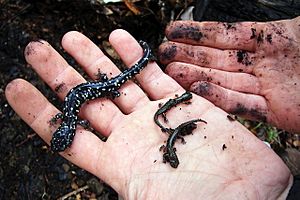Black salamander facts for kids
Quick facts for kids Black salamander |
|
|---|---|
 |
|
| Black Salamander mother and young | |
| Conservation status | |
| Scientific classification | |
| Synonyms | |
|
The black salamander (Aneides flavipunctatus) is a cool creature. It's also called the speckled black salamander. This salamander is part of the Plethodontidae family. That means it breathes through its skin and mouth, not with lungs!
This special salamander lives only in the United States. You can find it in forests and grasslands. Sadly, its home is shrinking because of habitat loss.
Meet the Black Salamander!
The black salamander can grow to be about 60 to 75 millimeters long. That's about the length of your pinky finger! Their color can be different. Some are black with white spots. Others are black with yellow spots. Some even look black with a bit of grey or green shine. Their belly is usually a lighter color. Young black salamanders are often greenish-grey or bronze. They also have yellow spots near their legs.
Where Do They Live?
Black salamanders live in forests and grasslands. You can find them along the coast of the southwestern United States. They usually live below 600 meters (about 2,000 feet) high. But sometimes they are found as high as 1,700 meters (about 5,600 feet)!
They live in a few separate areas. One group lives in the Santa Cruz Mountains. Then there's a gap where they don't live. Another group lives in northern California and southern Oregon.
In the southern parts of their home, they like to hide. They hide under logs and rocks in damp places. You might find them near stream banks in the woods. In the northern areas, they live in more open spaces. They can even be found among mossy rocks.
What Do They Do?
Black salamanders mostly live on the ground. But they have a special tail! It's called a prehensile tail. This means they can use it to grab things. So, they might climb sometimes, just like their cousin, the arboreal salamander (Aneides lugubris).
They eat small bugs. Their favorite snacks include millipedes, beetles, ants, and termites. Young salamanders eat similar things. But they also enjoy flies and springtails. Like other lungless salamanders, they are mostly active at night. During the day, they hide and rest.
We don't know much about how black salamanders have babies. They lay their eggs in July or August. They put them in underground spots. The eggs are attached to the moist soil. It seems the mother salamander stays with the eggs. She guards them until they hatch.
In labs, black salamanders can be aggressive towards each other. Wild adults often have scars. This might mean they protect their own space. They have even been known to bite a western garter snake if attacked!
Are They Safe?
The black salamander is listed as "Near threatened" by the IUCN Red List of Threatened Species. This means they could become endangered soon. Their biggest problem is habitat loss. Even in places where their home is still good, their numbers seem to be going down. In some areas, their land has been used for planting vineyards.
See also
In Spanish: Aneides flavipunctatus para niños


